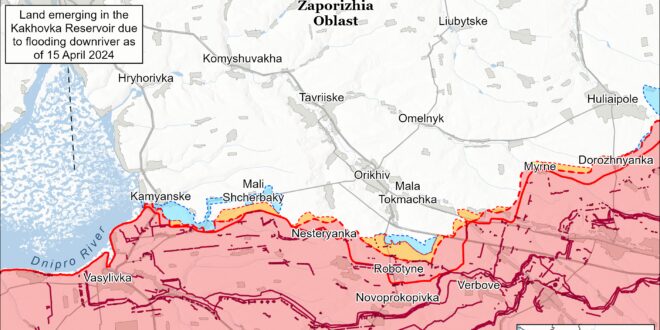We do not report in detail on war crimes because these activities are well-covered in Western media and do not directly affect the military operations we are assessing and forecasting. We utterly condemn violations of the laws of armed conflict and the Geneva Conventions and crimes against humanity even though we do not describe them in these reports.
NOTE: CTP and ISW will publish abbreviated updates on Saturdays and Sundays after February 8, 2025. We may publish full updates as events warrant, however.
Russian cargo vessels have continued to evacuate military assets from the port of Tartus as Russia negotiates its presence in Syria with the interim government. OSINT analyst MT Anderson posted satellite imagery from February 14 showing the Russian cargo vessel Baltic Leader and potentially the Admiral Golovko Admiral Gorshkov-class frigate about 250 kilometers south of the coast of southwestern Cyprus.[1] Anderson said that the Baltic Leader departed the port of Tartus sometime after February 4, when satellite imagery showed the vessel at the port.[2] It is unclear now if the Baltic Leader will bring evacuated Russian cargo to Russia or Libya. Russia sent some assets from Syria to Libya by air in December 2024 and January 2025.[3] Publicly available marine tracking data showed that two cargo vessels that departed Tartus in late January, the Sparta and Sparta II, were sailing off the coast of the Netherlands on February 15, presumably in transit to Russia.[4] Continued Russian-Syria engagement—including a recent phone call between Syrian Interim President Ahmed al Shara and Russian President Vladimir Putin—suggests that Syria seeks some relationship with Russia even as Russia withdraws its military assets from Syria.[5] Russian Ministry of Foreign Affairs spokesperson Maria Zakharova said on February 14 that Russia continues to discuss its military presence in Syria with the new Syrian administration.[6]
The Wall Street Journal reported on February 15 that Israeli officials requested to hold ground in five tactically significant locations in southern Lebanon after the expiration of the Israel-Lebanon ceasefire agreement.[7] The five sites Israel requested reportedly include sites near Khiam, Odaisseh, Naqoura, and Ramyeh, according to Lebanese officials. The Wall Street Journal noted that the five sites in Lebanon overlook Israeli towns in northern Israel and could ”give the military the ability to respond quickly to any threats.” Israeli officials reportedly made the request to American officials during negotiations in recent weeks. Lebanese media separately claimed on February 14 that the IDF intends to retain positions in the following areas:[8]
Tal Labbouneh, southeast of Naqoura, Lebanon.[9] Tal Labbouneh overlooks areas in southern Lebanon and northern Israel.[10]
Jabal Blat, northwest of Ramyeh, Lebanon. Jabal Blat is located approximately one kilometer from the Blue Line and overlooks western and central Lebanon.[11]
Tal Aaziyyeh, north of Odaisseh, Lebanon. Tal Aaziyyeh overlooks the Litani River.[12]
Tal al Awida, north of Odaisseh, Lebanon. Lebanese media noted that Tal al Awida is the “only hill” that overlooks Metula and "the rest” of the northern Israel towns in the northern tip of the Galilee panhandle.[13] Hezbollah frequently targeted Metula with drone and missile attacks between October 2023 and the Israel-Lebanon ceasefire in November 2024.[14]
Tal al Hamamis, south of Khiam, Lebanon. Tal al Hamamis is located approximately one kilometer from the Blue Line and provides a view of Metula, Israel, from the north.[15] Hezbollah media reported on February 14 and 15 that the IDF constructed bunkers and barriers on Tal al Hamamis.[16] CTP-ISW previously noted that Tal al Hamamis would have strategic significance to the IDF because control over Tal Hamamis would prevent Hezbollah from using the elevated terrain to conduct direct fire or support indirect fire attacks into the Upper Galilee from there.[17] 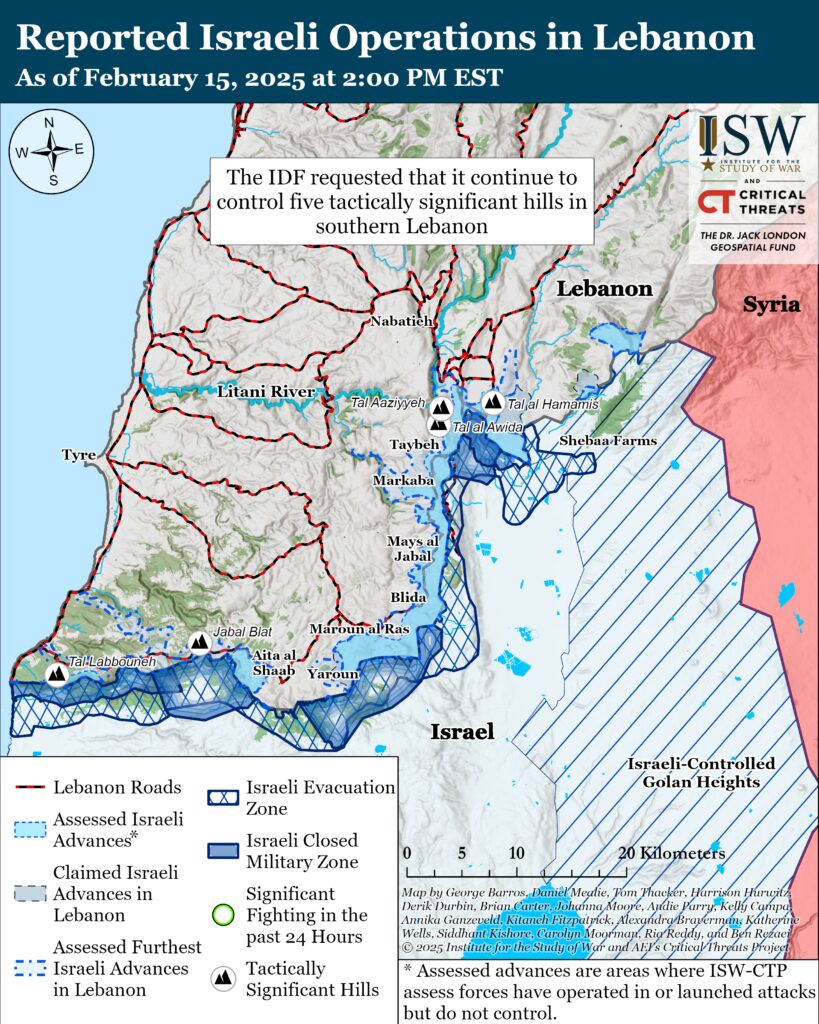
Hamas and Palestinian Islamic Jihad (PIJ) released three Israeli hostages on February 15.[18] Hamas transferred the hostages to the International Committee of the Red Cross in Khan Younis in the southern Gaza Strip.[19] Israel released 369 Palestinian prisoners in exchange, including 111 whom the Israel Defense Forces (IDF) detained in the Gaza Strip during the October 7 War.[20] BBC reported that Israel will deport an unspecified number of Palestinian prisoners to Egypt.[21]
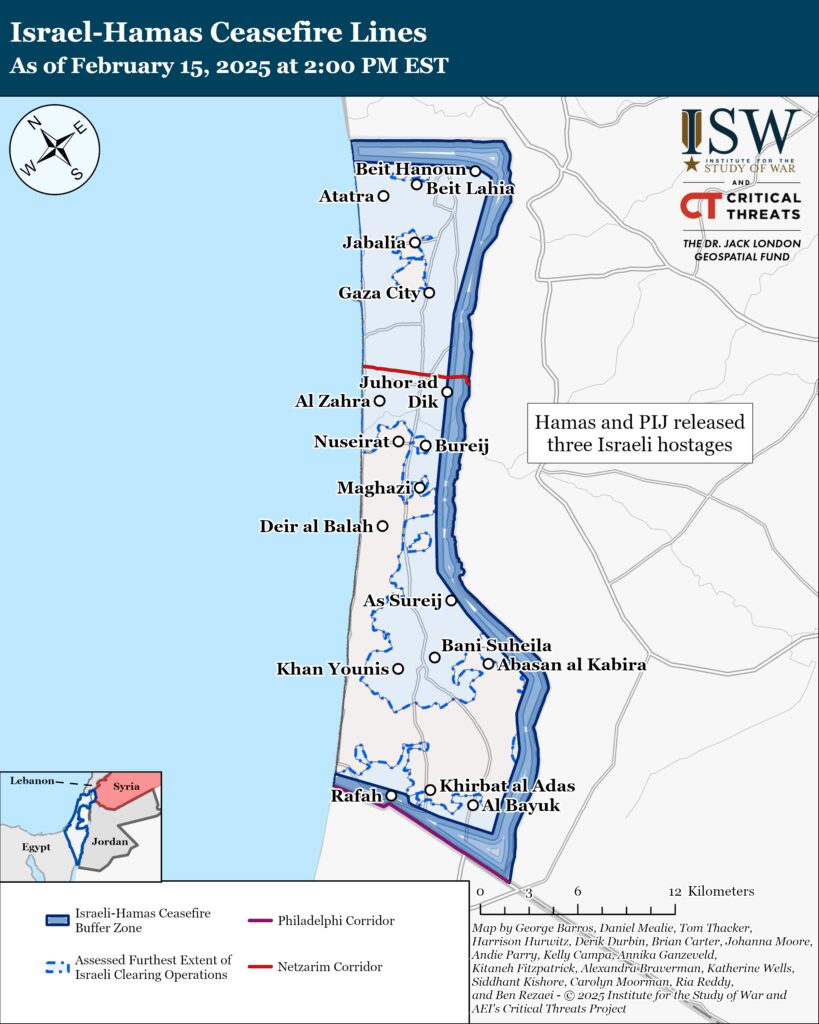
Pro-Hezbollah protesters set fire to a vehicle in a United Nations Interim Force in Lebanon (UNIFIL) convoy and injured a UNIFIL officer during protests outside Beirut’s Rafic Hariri International Airport on February 14.[22] The protests began on February 13 after Lebanese authorities prevented an Iranian Mahan Air flight likely smuggling cash to Hezbollah from landing in Beirut.[23] Lebanese security forces detained over 25 individuals involved in the attack.[24] CTP-ISW previously noted that Iran’s efforts to compel Lebanon to allow Iranian aircraft transporting funds to Hezbollah to land in Beirut is tantamount to an Iranian effort to compel Lebanon to violate the Israel-Lebanon ceasefire agreement.
Key Takeaways:
Russia in Syria: Russian cargo vessels have continued to evacuate military assets from the port of Tartus as Russia negotiates its presence in Syria with the interim government.
IDF in Lebanon: The Wall Street Journal reported on February 15 that Israeli officials requested to hold ground in five tactically significant locations in southern Lebanon after the expiration of the Israel-Lebanon ceasefire agreement.
Gaza Strip: Hamas and Palestinian Islamic Jihad (PIJ) released three Israeli hostages.
Hezbollah in Lebanon: Pro-Hezbollah protesters set fire to a vehicle in a United Nations Interim Force in Lebanon (UNIFIL) convoy and injured a UNIFIL officer during protests outside Beirut’s Rafic Hariri International Airport on February 14.Syria
Turkey conducted drone strikes targeting several SDF vehicles in western Raqqa Province on February 15. Several anti-SDF outlets reported that Turkish drones struck two SDF vehicles in al Jarniyah and killed an unknown number of SDF members inside.[25] Anti-SDF media also reported that a Turkish drone later struck an SDF vehicle in the adjacent Mazyouna village and killed three SDF members.[26] Mazyouna is located along a key supply line from Raqqa to Tishreen Dam. Turkey has repeatedly targeted the SDF supply line since late December 2024 to try to isolate the SDF around Tishreen Dam.[27]
Syrian media reported that several SDF 122mm Grad rockets struck civilian areas in Khafsah, south of Tishreen Dam, on February 15.[28] Syrian media reported that the SDF rockets killed a civilian, injured six others, and caused significant material damage to a house and a mosque.[29]
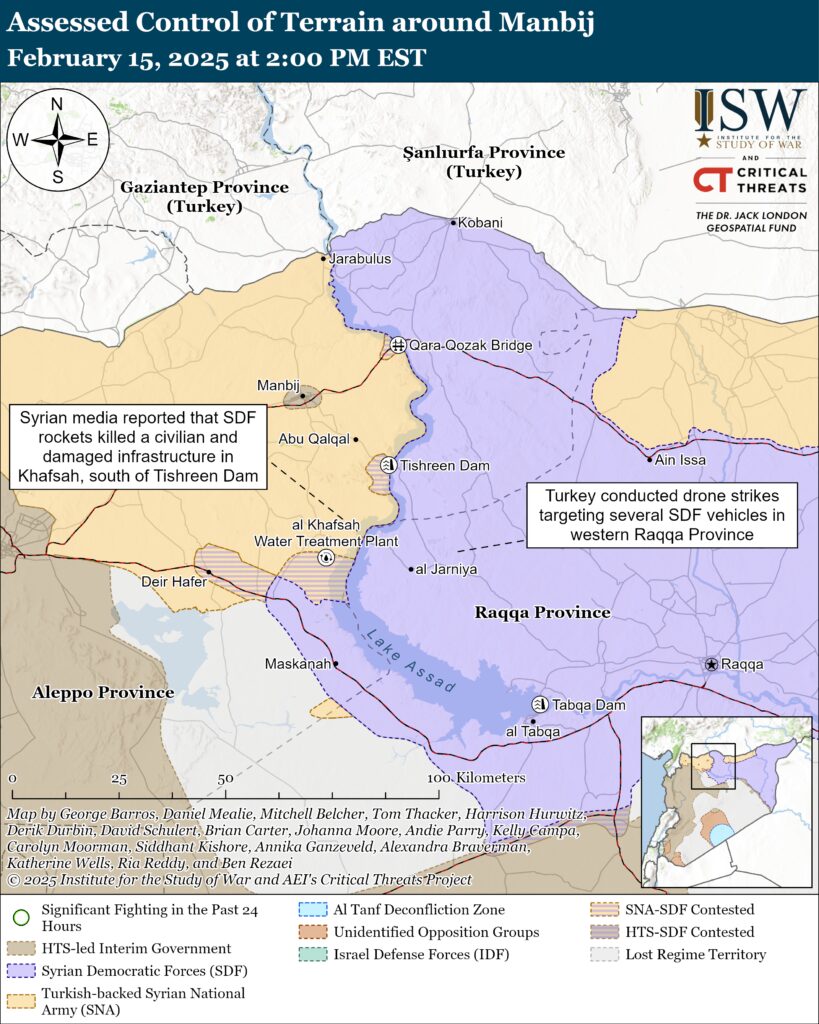
Syrian intelligence services arrested an Islamic State of Iraq and Syria (ISIS) leader who was reportedly involved in the attempted attack on Sayyida Zeinab shrine. A Syrian intelligence source told Syrian state media on February 15 that intelligence services arrested ISIS leader Abu al Harith al Iraqi.[30] The source said that Abu al Harith provided guidance to the ISIS cell that planned a suicide bombing attack at the Sayyidah Zeinab shrine.[31] The Syrian government thwarted the attack attempt and arrested the cell using US intelligence on January 11.[32] The source said that Abu al Harith planned the killing of Maysar al Jubouri (aka Abu Maria al Qahtani), a former senior Jahbat al Nusra leader. [33] The source did not specify where the arrest took place.[34]
Syrian media reported that the international coalition conducted a drone strike targeting a vehicle along the M4 highway in southern Idlib on February 15.[35] Syrian Civil Defense said that the drone strike took place along the M4 highway near Orem al Jawz, Idlib Province.[36] The strike reportedly killed two people.[37] US Central Command (CENTCOM) has not confirmed any drone strikes in Syria as of this writing.
The Syrian Democratic Council (SDC) criticized the Syrian National Dialogue Conference Preparatory Committee’s lack of diversity on February 15.[38] The Syrian interim government announced the members of the committee on February 12.[39] The preparatory committee is mostly comprised of pro-HTS individuals who are loyal to Shara and does not appear to include representatives of the Alawite, Druze, Kurdish, and Shia communities.[40] The SDC said that it is concerned that the preparatory committee for the National Dialogue Conference is “from a single spectrum and political orientation.”[41] The SDC criticized the committee because it fails to represent all Syrians and asserted that it deliberately excluded other opposition groups.[42]
Syrian Interim Foreign Affairs Minister Asaad al Shaibani met with several officials on the sidelines of the Munich Security Conference in Germany on February 15.[43] Shaibani met with German Foreign Minister Annalena Baerbock, Turkish Foreign Minister Hakan Fidan, British Foreign Secretary David Lammy, Norwegian Foreign Minister Espen Barth Eide, and the United Nations High Commissioner for Human Rights Volker Turk. Shaibani also held talks with German Deputy Interior Minister Hans-Georg Engelke.[44] Discussions covered bilateral relations, security, and regional developments.
Syrian Interim Foreign Affairs Minister Asaad al Shaibani met with Kurdistan Regional Government (KRG) President Nechirvan Barzani in Munich on February 15, almost certainly to discuss ongoing relations with the SDF. The meeting occurred on the sidelines of the Munich Security Conference5.[45] Shaibani and Barzani discussed the importance of working to deepen cooperation to confront regional challenges.[46]
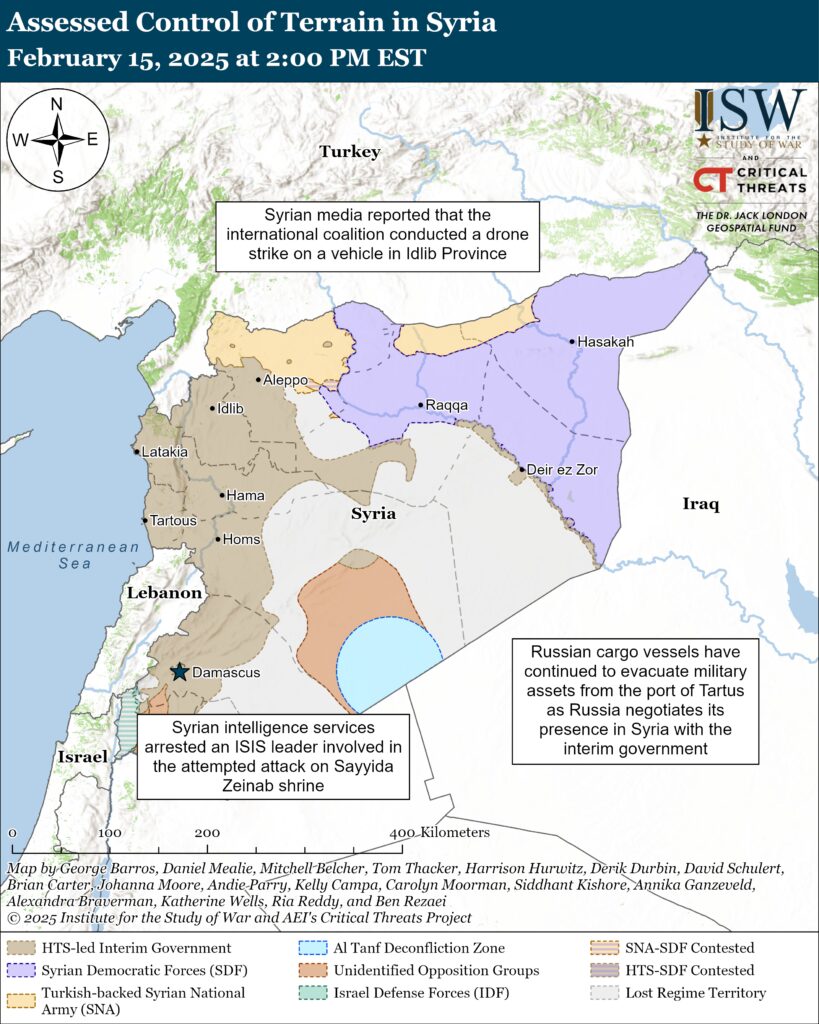
Iraq
Axis of Resistance objectives:
Strengthen Iranian and Axis of Resistance influence over the Iraqi state and society
Harden the Iraqi government against internal dissentNothing significant to report.
Arabian Peninsula
Axis of Resistance objectives:
Harden the Houthi regime against internal dissent in Houthi-controlled areas
Destroy the anti-Houthi opposition in order to control all of Yemen
Erode Israeli will to continue the war in the Gaza StripNothing significant to report.
The Palestinian Territories and Lebanon
Axis of Resistance objectives:
Erode the will of the Israeli political establishment and the public to sustain clearing operations in the Gaza Strip
Reestablish Hamas as the governing authority in the Gaza Strip
Rebuild and reestablish Hezbollah in southern Lebanon
Establish the West Bank as a viable front against IsraelThe Gaza Strip
See the topline section.
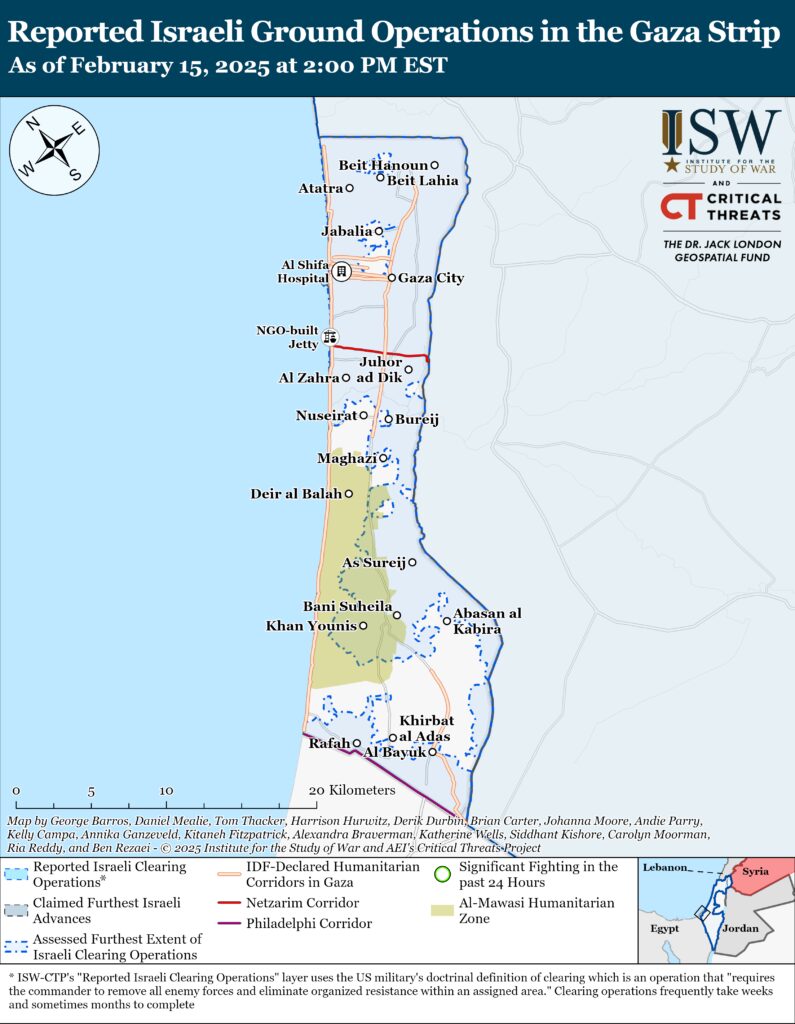
Lebanon
See the topline section.
West Bank
Nothing significant to report.
Iranian Decision-Making, Internal Dynamics, and Foreign Policy
The Special Envoy of the Iranian Foreign Affairs Ministry for Syrian Affairs, Mohammad Reza Raouf Sheibani, confirmed that Iran and the Syrian interim government communicate through intermediaries.[47] Sheibani stated that Iran communicates indirectly with current Syrian officials and has received messages from Syria. Sheibani separately met with Russian President Vladimir Putin’s Special Representative for Syrian Affairs, Alexander Lavrentiev, and Special Presidential Representative for the Middle East and North Africa, Mikhail Bogdanov, in Moscow on February 15.[48] The meeting covered developments in West Asia and Syria.
The Iran Update provides insights into Iranian and Iranian-sponsored activities abroad that undermine regional stability and threaten US forces and interests. It also covers events and trends that affect the stability and decision-making of the Iranian regime. The Critical Threats Project (CTP) at the American Enterprise Institute and the Institute for the Study of War (ISW) provides these updates regularly based on regional events.
CTP-ISW defines the “Axis of Resistance” as the unconventional alliance that Iran has cultivated in the Middle East since the Islamic Republic came to power in 1979. This transnational coalition is comprised of state, semi-state, and non-state actors that cooperate to secure their collective interests. Tehran considers itself to be both part of the alliance and its leader. Iran furnishes these groups with varying levels of financial, military, and political support in exchange for some degree of influence or control over their actions. Some are traditional proxies that are highly responsive to Iranian direction, while others are partners over which Iran exerts more limited influence. Members of the Axis of Resistance are united by their grand strategic objectives, which include eroding and eventually expelling American influence from the Middle East, destroying the Israeli state, or both. Pursuing these objectives and supporting the Axis of Resistance to those ends have become cornerstones of Iranian regional strategy.
 Eurasia Press & News
Eurasia Press & News
